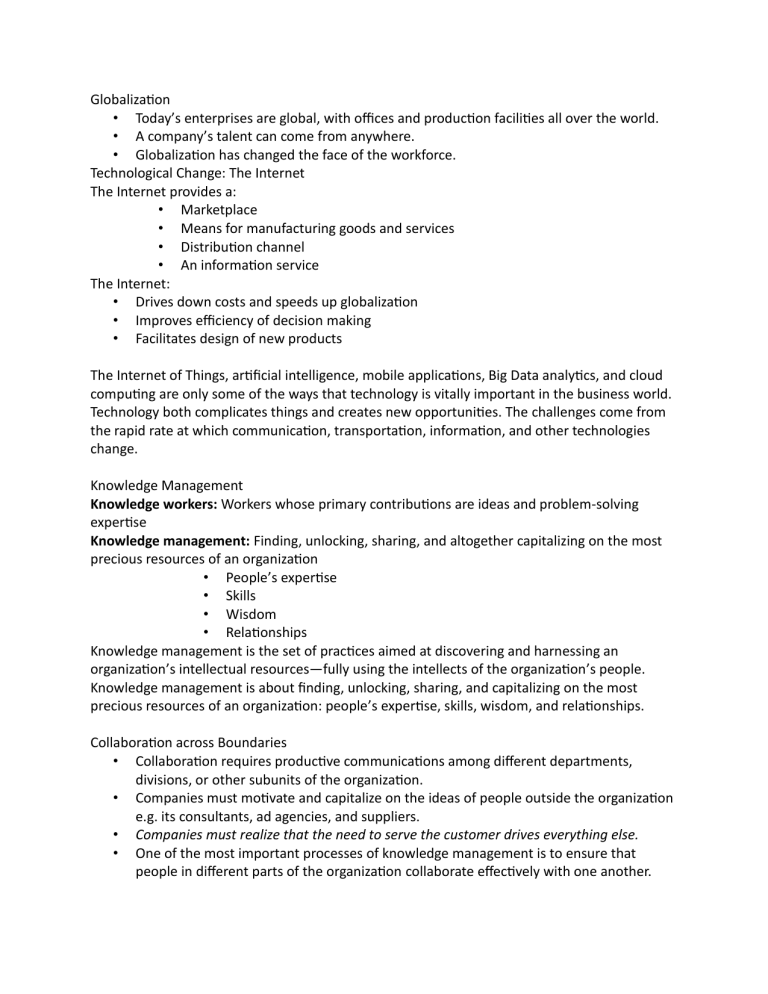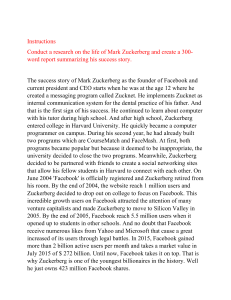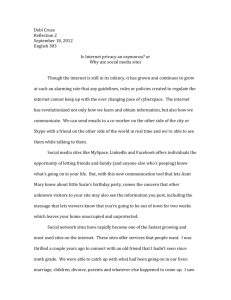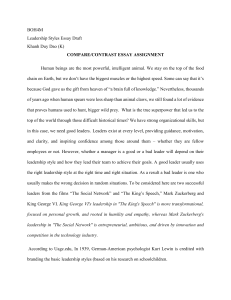
Globalization • Today’s enterprises are global, with offices and production facilities all over the world. • A company’s talent can come from anywhere. • Globalization has changed the face of the workforce. Technological Change: The Internet The Internet provides a: • Marketplace • Means for manufacturing goods and services • Distribution channel • An information service The Internet: • Drives down costs and speeds up globalization • Improves efficiency of decision making • Facilitates design of new products The Internet of Things, artificial intelligence, mobile applications, Big Data analytics, and cloud computing are only some of the ways that technology is vitally important in the business world. Technology both complicates things and creates new opportunities. The challenges come from the rapid rate at which communication, transportation, information, and other technologies change. Knowledge Management Knowledge workers: Workers whose primary contributions are ideas and problem-solving expertise Knowledge management: Finding, unlocking, sharing, and altogether capitalizing on the most precious resources of an organization • People’s expertise • Skills • Wisdom • Relationships Knowledge management is the set of practices aimed at discovering and harnessing an organization’s intellectual resources—fully using the intellects of the organization’s people. Knowledge management is about finding, unlocking, sharing, and capitalizing on the most precious resources of an organization: people’s expertise, skills, wisdom, and relationships. Collaboration across Boundaries • Collaboration requires productive communications among different departments, divisions, or other subunits of the organization. • Companies must motivate and capitalize on the ideas of people outside the organization e.g. its consultants, ad agencies, and suppliers. • Companies must realize that the need to serve the customer drives everything else. • One of the most important processes of knowledge management is to ensure that people in different parts of the organization collaborate effectively with one another. This requires productive communications among different departments, divisions, or other subunits of the organization. Staying Ahead of the Competition The best managers and companies deliver on multiple performance dimensions. • Innovation • Quality • Service • Speed • Cost Competitiveness • Sustainability To succeed, managers must deliver performance. The fundamental success drivers of performance are innovation, quality, service, speed, cost competitiveness, and sustainability. Don’t assume that you can settle for delivering just one of the six competitive advantages: low cost alone, or quality alone, for example. Managing for Competitive Advantage: Innovation A firm must: • Adapt to changes in consumer demands and to new competitors • Be ready with new ways to communicate with customers and deliver the products to them • Innovation is the introduction of new goods and services. Products don’t sell forever; in fact, they don’t sell for nearly as long as they used to because competitors are continuously introducing new products. Your firm must innovate, or it will die. Managing for Competitive Advantage: Quality Quality The excellence of your product (goods or services) • Historically, quality referred to attractiveness, lack of defects, reliability, and longterm dependability. • Today it is about preventing defects before they occur, achieving zero defects in manufacturing, and designing products for quality. • Most companies claim that they are committed to quality. In general, quality is the excellence of your product. Customers expect high-quality goods and services, and often they will accept nothing less. Managing for Competitive Advantage: Service and Speed Service • Giving customers what they want or need, when they want it • Continually meeting the needs of customers to establish mutually beneficial longterm relationships • Speed • Fast and timely execution, response, and delivery of results • Service means giving customers what they want or need, when they want it. • The speed requirement has increased exponentially. Everything, it seems, is on fastforward. Speed is no longer just a goal of some companies; it is a strategic imperative. Managing for Competitive Advantage: Cost and Sustainability Cost competitiveness Keeping costs low to achieve profits and be able to offer prices that are attractive to consumers Sustainability Minimizing the use of resources, especially those that are polluting and nonrenewable Cost competitiveness means keeping costs low enough so that the company can realize profits and price its products (goods or services) at levels that are attractive to consumers. Avoiding wasteful use of energy can bolster a company’s financial performance while being kind to the environment. Efforts to cut energy waste are just one way to achieve an important form of competitive advantage: sustainability, which at its most basic is the effort to minimize the use and loss of resources, especially those that are polluting and nonrenewable. Social Enterprise Ashoka’s Bill Drayton, Pioneer of Social Entrepreneurship In Drayton’s view, anyone can be a social entrepreneur. All it takes, he says, is the ability to see a problem, put others’ skepticism aside, and allow yourself the time to inch your way first toward a vision and then to a solution that works. Questions Do you think every manager should have the responsibility to do good and do well? Why or why not? Student discussion will vary and may focus on how to do “good,” and when and if such activities are appropriate. Students may debate between profit and social responsibility type actions. What other means to create social innovation besides efforts like Ashoka’s do you think can be effective? Student answers will vary; however, government, nonprofit and church activities may be mentioned. Students may also discuss social media-based activities. Management Defined Management Working with people and resources to accomplish organizational goals efficiently and effectively Management is the process of working with people and resources to accomplish organizational goals. Good managers do those things both effectively and efficiently. To be effective is to achieve organizational goals. To be efficient is to achieve goals with minimal waste of resources—that is, to make the best possible use of money, time, materials, and people. The Four Functions of Management Planning: Systematically making decisions about the goals and activities that will be pursued Organizing: Assembling and coordinating the resources needed to achieve goals Controlling: Monitoring performance and making needed changes Leading: Stimulating people to be high performers Performing All Four Management Functions • A typical day for a manager is not neatly divided into the four functions. • Days are fractionated and spent dealing with interruptions, meetings, and firefighting. Good managers devote adequate attention and resources to all four management functions Some managers are particularly interested in, devoted to, or skilled in one or two of the four functions but not in the others. But you should devote adequate attention and resources to all four functions. Management Levels Top-Level Managers Middle-Level Managers Frontline Managers Top-level managers are the senior executives of an organization and are responsible for its overall management. Middle-level managers are located in the organization’s hierarchy below top-level management and above the frontline managers. Sometimes called tactical managers, they are responsible for translating the general goals and plans developed by strategic managers into more specific objectives and activities. Frontline managers, or operational managers, are lower-level managers who supervise the operations of the organization. These managers often have titles such as supervisor, team leader, or assistant manager. Managerial Roles: What Managers Do Decisional Roles: • Entrepreneur • Disturbance handler • Resource allocator • Negotiator Informational Roles: • Monitor • Disseminator • Spokesperson Interpersonal Roles • Leader • Liaison • Figurehead A classic study of top executives found that they spend their time engaging in 10 key activities or roles, falling into three categories: interpersonal, informational, and decisional. Exhibit 1.2 summarizes these roles. This slide shows an abbreviated version of Exhibit 1.2. Management Skills Technical : The ability to perform a specialized task involving a particular method or process Conceptual and decision: Skills pertaining to the ability to identify and resolve problems Interpersonal and Communication: People skills; the ability to lead, motivate, and communicate Performing management functions and roles, and achieving competitive advantage, are the cornerstones of a manager’s job. However, understanding this does not ensure success. Managers need a variety of skills to do these things well. career Emotional intelligence The skills of understanding yourself, managing yourself, and dealing effectively with others Social capital Goodwill stemming from your social relationships • Be both a specialist and a generalist. • Be self-reliant. • Connect. • Actively manage your relationship with your organization. • Survive and thrive. Throughout your career, you’ll need to lead teams effectively as well as influence people over whom you have no authority; thus the human skills are especially important. Business people often talk about emotional intelligence, or EQ—the skills of understanding yourself (including strengths and limitations), managing yourself (dealing with emotions, making good decisions, seeking and using feedback, exercising self-control), and dealing effectively with others (listening, showing empathy, motivating, leading, and so on). We have noted the importance of taking responsibility for your own actions and your own career. Unless you are self-employed and your own boss, one way to do this is to think about the nature of the relationship between you and your employer. The exhibit shows two possible relationships—and you have some control over which relationship develops. You can contribute with your conceptual and human skills and your managerial actions. You can execute the essential management functions and deliver competitive advantage. Today, managers must do more, better. Eminent management scholar Peter Drucker, in considering what makes managers effective, noted that some are charismatic whereas some are not, and some are visionary whereas others are more numbers-oriented. But successful executives do share some common practices. Management in Action Working for Facebook’s Mark Zuckerberg Zuckerberg believes that unless employees are able to express their creativity their impact will be minimized and they are likely to leave. He is famous for saying, “I will only hire someone to work directly for me if I would work for that person.” As an early career employee at Facebook, what steps could you take to get noticed and position yourself for eventual promotion to frontline manager? Said to be forward-looking, disciplined, inquisitive, consistent, and good at communicating, Mark Zuckerberg recently earned a 99.3 approval rating from Facebook employees. Zuckerberg believes “[employees] need the ability to fully exercise all their creativity and all their capacity, or else they’re not going to be having the biggest impact that they can have on the world, and they’re going to want to go do something else.” He’s also famous for saying, “I will only hire someone to work directly for me if I would work for that person.” Zuckerberg has delegated the commercial side of Facebook’s operations to chief operating officer Sheryl Sandberg. This leaves him free to stay focused on the technical aspects that led him to start the social media giant as a simple site he once ran from his Harvard dorm room. As an early career employee at Facebook, what steps could you take to get noticed and position yourself for eventual promotion to frontline manager? Most of Facebook’s core top employees have been with the company for much of its 13-year life. What do you think accounts for their commitment? Tell the class anything you might feel is interesting and/or relevant to a course. Please tell the class where you live. Please share what you are majoring in and how a course like this one is relevant to your degree completion. Think carefully about what and how you want to present yourself to the class. Feel free to include an image of yourself.





